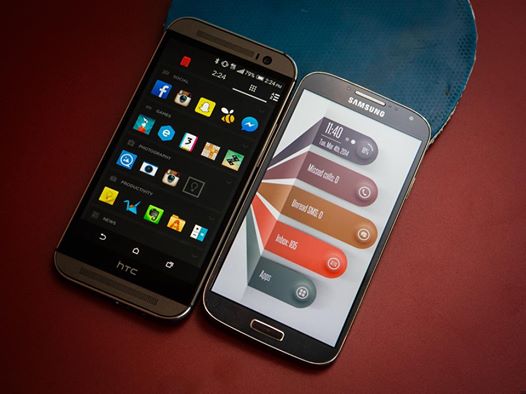
Android launchers are apps that can spice up your phone’s home screen or act as a personal assistant. Here’s what you need to know about how they work and how to choose one that’s right for you.

Almost every launcher falls into one of two categories: design or “smart.” Design launchers focus on letting you change the entire layout of your Android phone’s home screen, creating simple designs or more elaborate ones that look like carved wood or a collage of photos. You also can add custom gestures to your phone, such as double-tapping the screen to open a specific app.
“Smart” or adaptive launchers seek to put the most relevant information front and center throughout your day, as you wake up, head out on your commute, work at the office, and spend a night on the town or at home watching TV. I prefer to call “smart” launchers home-screen replacements because they replace your normal home screen setup with a new experience. Just remember that you often cannot modify your phone’s design using a home screen replacement. Below, I’ll discuss both categories in more detail.

Let’s first take a look at design launchers, which were the first type of launchers to really take off in the Android community. These apps are used to modify or completely overhaul your Android home screen, which you reach by tapping your phone’s home button or hotkey. This is where your wallpaper and widgets live, and where you can store shortcuts to apps.
Design launchers act as a foundation that you can build upon with icon packs, widgets, and wallpapers. These apps serve to “unlock” existing design limitations, such as how many apps you can fit on individual home screens, to allow for deeper modifications. You can make some changes to the look and feel of your phone with these apps alone, but the fun really starts when you download icon packs, play around with widgets, and hunt for unique wallpapers. Icon packs change how the icons for some or all of the apps look on your phone. Most packs are free or cost a few bucks, and you need a launcher on your phone to use them.
Arguably the most popular design launchers are Nova, Apex, and Go Launcher EX. All three have been around for a few years and give you free license to rearrange your home screens, and even your app drawer. A few newcomers that are worth checking out are Dodol and Buzz Launcher.
- Chamisa under fire over US$120K donation
- Mavhunga puts DeMbare into Chibuku quarterfinals
- Pension funds bet on Cabora Bassa oilfields
- Councils defy govt fire tender directive
Keep Reading
If you poke around the Internet, you can find some stunning designs that people have created with the help of Nova, Apex, or other apps like them. Some examples rely on widget tools, such as Ultimate Custom Widget (UCCW) to carefully arrange specific design elements on your phone’s screen.
Worth mentioning is the Themer launcher, which was built by the same people who run MyColorscreen, a website for showing off custom home screens. Themer makes the process of tweaking your phone’s aesthetic infinitely easier because you use premade designs built by a community of Android enthusiasts. All you need to do is find a theme you like, press a few buttons, and it’s loaded onto your phone. You can switch up your theme as often as you like, without needing to devote hours to moving around apps and widgets or changing icon packs.

So-called smart home-screen replacements have very different goals from those of design launchers. These apps seek to put the apps and information you need right in front you, so that, ideally, you’ll never have to hunt around your phone ever again.
With most of these home-screen replacements, they get smarter the more you use them because they learn which apps you use the most. Some even ask for your home and work addresses, so they know when you’re at home or at the office and can show you appropriate apps for each situation.
The top home-screen replacements are Yahoo-owned Aviate and EverythingMe. Aviate comes with its own unique design that organizes your apps and widgets into their own cards to keep things tidy. The app is always aware of your location, so it can show you the right apps and widgets when you wake up in the morning, commute to the office, walk around looking for lunch, or plug in your headphones to listen to music. You can’t do much to alter Aviate’s design, but you can use custom icon packs and change the theme from light to dark.
EverythingMe emphasizes search, with a large search bar on your home screen that you can use to find apps and contacts or to search the Web for the information you need. This launcher also automatically organizes your apps into “smart folders” based on category, such as social or fitness, and will suggest new apps you can download in each category.
Another choice is newly-launched, US-only Terrain, which was born out of the Samsung Accelerator program, and designed to replace TouchWiz. It’s not just for Samsung phones though; it works on any phone running Android 4.1 and up. Terrain is more subtle than Aviate and EverythingMe, leaving your home screen relatively untouched. It comes with two menus, one that houses helpful widgets for your Facebook news feed, your recent apps, your calendar, and more, while the other menu organizes your apps in an alphabetical list so they are easy to find.
You might remember that Facebook also tried its hand at a home-screen replacement with Facebook Home, which really just transformed your phone into a full-screen News Feed. It’s still available in Google Play if you want it, but the app’s popularity has dwindled since it was released with the HTC First, also known as the “Facebook phone,” in 2013.
What’s the point of all this?Using launchers can be overwhelming at first, and they aren’t necessary to get a good Android experience. Still, it’s worth playing around with launchers, because they can add a lot of value and breathe new life into phones with dated software or irritating stock features.
Even if you like your phone’s setup as is, I urge you to play around with a launcher or two. You might be pleasantly surprised with what you can do with a new design, or how convenient it is when the apps you need appear when you need them. And if not, you can always go back to your stock experience with just a few taps.
Tips to rememberIf you’re using launchers for the first time, here are some tips to get you started.

Themer is my top pick for an introductory design launcher. It comes with hundreds of predesigned themes that help inspire you to create your own designs. Once you’ve mastered it, I suggest trying out Nova.
– CNET









